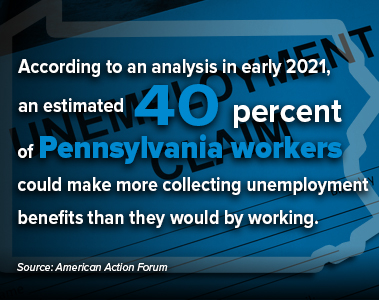Among the many challenges employers have faced during this pandemic has been a shortage of workers to fill open positions. We’ve all seen “Now Hiring” signs throughout our communities – which often include starting wages well above the state minimum – and in some workplaces, there are even signs urging customers to exhibit patience because of service delays due to limited staffing. As most small business owners know, the main culprit has been a continued $300 a week federal Unemployment Compensation benefit, in addition to benefits at the state level – a situation that has overwhelmed our state’s UC system and made it ripe for fraud and abuse.
 PA Chamber President Gene Barr recently relayed the business community’s concerns about this crisis to lawmakers on the state Senate Community, Economic and Recreational Development Committee when he testified at a public hearing that focused on the economic impact of the ongoing workforce shortage. He shared the challenges employers have faced over the last several months, telling committee members, “We continually hear from our members that despite the availability of vaccines, Pennsylvania’s high unemployment rate and employers significantly raising wages, they still have difficulty filling open positions. This has forced employers across a broad spectrum of industries – including restaurants, construction, manufacturing and supply chain/logistics firms – to reduce hours or even close operations.”
PA Chamber President Gene Barr recently relayed the business community’s concerns about this crisis to lawmakers on the state Senate Community, Economic and Recreational Development Committee when he testified at a public hearing that focused on the economic impact of the ongoing workforce shortage. He shared the challenges employers have faced over the last several months, telling committee members, “We continually hear from our members that despite the availability of vaccines, Pennsylvania’s high unemployment rate and employers significantly raising wages, they still have difficulty filling open positions. This has forced employers across a broad spectrum of industries – including restaurants, construction, manufacturing and supply chain/logistics firms – to reduce hours or even close operations.”
The hearing also focused on the generous benefits, wages and signing bonuses employers are extending to potential employees to entice them to rejoin the labor pool. Of course, the workforce shortage crisis isn’t only due to continued UC benefits. Other pandemic-related obstacles have prevented people from re-entering the workforce, including lack of access to childcare – an issue the PA Chamber identified in a recent report and is focused on addressing for the future. As Pennsylvania’s unemployment rate continues to hover around one percentage point higher than the national average, this public hearing was welcomed as a way to raise awareness around the problems employers are facing on a daily basis as we work to advance public policy solutions.